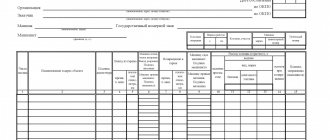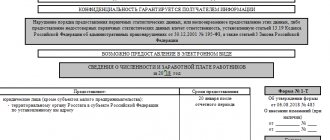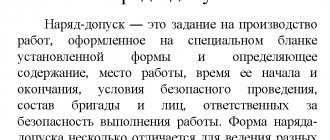What is a work permit for work in electrical installations?
In fact, this document is a kind of permission to carry out work of this type. As a rule, it includes exactly those types of work that this document allows to perform. The names of the specialists to whom the work is entrusted are indicated here. The team leader and those responsible for the work process are also noted.
In addition, the document contains information about safety measures and workplace preparation rules. For example, if some devices are turned off, this must be indicated in the document. In addition to disconnecting, you need to enter information about the grounding of specific objects.
A special form is used to complete the attire. The document is necessary in all situations when a specialist cannot simply come and do the necessary work. Responsible persons note in the work order all the manipulations carried out aimed at the safe performance of work. Each employee who is part of the team that will work in electrical installations is familiarized with the safety rules and methods of preparing the workplace.
What is the list of works
The main purpose of the outfit is to clearly display what kind of work specialists can do. The absence of this document is a gross violation of maintenance rules and regulations. Most often, a work permit is required for the following work:
- digging holes in the ground, the depth of which exceeds one and a half meters, and carrying out work in them;
- work related to digging the ground near energy networks, gas and oil pipes and various communications that are located underground;
- work aimed at repairing and strengthening some parts of buildings, as well as related to the demolition of various structures;
- construction and other work that is performed at height;
- restoring the functionality of hot water and steam pipelines;
- work carried out on buildings where there are no protective fences around the roof perimeter;
- transportation, lifting and lowering of large and heavy loads, if there are no devices necessary for working with such loads;
- repair of devices and equipment whose height exceeds two meters;
- work at height, such as repairing and maintaining lamp posts or cranes;
- work in a confined space of a small area;
- welding work associated with tanks, tunnels, reservoirs and other containers in which flammable substances were stored;
- repair of pipelines in which gas, steam or water passes under pressure;
- draining, transporting or other work with alkalis, acids, flammable liquids;
- work related to ventilation hoods, chemical laboratories, in rooms with hazardous materials and radioactive substances;
- cleaning containers in which cyanide compounds were stored;
- repairs on ammonia and oxygen compressors and pipelines;
- transportation of powerful pesticides;
- recycling of chemical industry waste, alkali metals and poisons;
- repair of installations on overhead power lines;
- work using a crane that has to work near power lines;
- performing hazardous work related to the gas system;
- work in premises associated with an increased risk of fires and explosions.
Rules for issuing a work permit
The law does not provide for the use of a single form for drawing up this document. For specific types of work, a special form is used. This is stated in regulations. In addition, such documents can be designed differently in different departments and workshops.
The absence of a single form is explained by the fact that in specific cases it is necessary to enter additional points that reflect the essence of the work in specific conditions. Columns can be added in accordance with internal orders and instructions.
Despite the fact that a fairly large number of varieties of outfits can be used, they all have the same purposes. In addition, their content remains the same. Also, the design rules are almost the same:
- the document must be completed before the start of hazardous work;
- the work order is issued precisely in the division of the enterprise in which these works are planned to be carried out;
- in a special journal that must be present in the company, a mark is placed indicating that the order has been issued;
- at the discretion of the responsible persons, the document is issued for one work shift, or for the entire period during which repair work is planned. In this case, the document is only extended for subsequent shifts, before each start. In this case, the work must be performed by only one team;
- the document must have two copies. All marks contained in it must be clearly legible. No corrections can be made here;
- if dangerous work is performed by two groups of specialists, each of them must receive a separate outfit. Moreover, foremen need to familiarize themselves with the activities that were specially designed for joint work;
- technological lines, structures and areas where hazardous work will be performed by the contract team must be transferred under the appropriate act. However, this is done if all work in this area is stopped. In the event that gas, electric or steam wires operate here, hazardous work cannot be carried out at the facilities;
- if it is planned to carry out work in close proximity to hidden and overhead communications, it will be necessary to coordinate their implementation in advance with the relevant enterprises. At the same time, in addition to the work order, the team of specialists must receive hidden communication diagrams and permitting documents.
How long is it issued?
A permit to carry out hazardous work is tied to a specific person and place. Particular attention should be paid to the fact for how long this document is valid. So, the permit must be in two copies. The specialists who will carry out the work receive one of them in their hands. The second is sent to the folder for storing work orders for uncompleted work. She is usually located in the control room.
As a rule, a new outfit must be issued for each shift. However, it is possible to issue a work order whose duration of work is quite long. This document is renewed before each work shift.
https://youtu.be/OboPQk9D-B0
Work permit for work in electrical installations (hereinafter referred to as the work order) is a task for the performance of work, drawn up on a special form in accordance with Appendix 1 and defining the composition of the team and workers responsible for the safe performance of work, indicating their electrical safety groups, content and location work, start and end times of work and conditions for its safe performance (measures for preparing workplaces);
The work order is issued in two copies, one of which is issued to the work performer (supervisor), the second remains with the permitter or the person issuing the work order, if there are no operational and repair personnel at this site. The validity period of the order is determined by the person issuing the order, but not more than 15 calendar days. If the work order has expired and the work has not been completed, the work order is extended only once for a period of no more than 15 calendar days.
order - an assignment to perform work, defining its content, place, time, labor protection measures and workers entrusted with its implementation. The order must be documented in the work log for work orders and orders. Admission to work according to the order must be carried out after a targeted briefing on labor protection and documented in the work log for work orders and orders in accordance with Appendix 7.
The order can be transmitted directly or using means of communication with subsequent entry in the operational journal;
The order is of a one-time nature, its validity period is determined by the length of the executors’ working day. If it is necessary to continue work, or if there is a change in its conditions or the composition of the team, the order must be issued again. It is allowed to issue an order to work alternately on several electrical installations
Actions of workers in case of detection of a violation of the Safety Rules when working in electrical installations, as well as a malfunction of the electrical installation or protective equipment.
Workers who discover violations of these Intersectoral Rules and other regulatory legal acts, as well as those who notice a malfunction of the electrical installation or protective equipment, are required to immediately report this to their immediate supervisor, and in his absence, to their superior manager.
In cases where a malfunction in an electrical installation that poses a clear danger to workers or objects can be eliminated by workers who discover it, they are obliged to eliminate the malfunction immediately in compliance with labor safety requirements, and then report this to their immediate supervisor
Ticket No. 16
Shelf life
After the hazardous work has been completed, the document is moved to the folder with work orders for the work performed. It needs to be stored here for one month. After this period, the document can be disposed of. If an unforeseen situation arises in which damage to the property or health of an employee was caused, an investigation begins. A permit must be attached to this case. In this case, the document is stored for 45 years.
The company's charter may provide for mandatory storage of these work orders. In this case, the documents, after being stored for a month, are sent to the archive.
Works and list
All main types of work at power plants, substations, and other electrical installations are formalized accordingly and carried out in accordance with the “Instructions for Labor Safety during the Operation of Electrical Installations.”
To perform complex work or tasks that require a large number of shutdowns of operating equipment and technical measures, the rules require the issuance of a work permit for electrical installations. Many lists of work performed according to the work permit in electrical installations often include:
- work for which it is necessary (for the safety of workers) to remove voltage from live parts of equipment being repaired or located nearby;
- work in panels and assemblies with relay protection, during their debugging and adjustment, using high-voltage testing equipment;
- work requiring the use of lifting machines, cranes, cradles and other mechanisms on the territory of an existing electrical installation under voltage;
- excavation, transfer (relaying) of live cables;
- activities that require lifting to a height of more than 3 m, such as cleaning or painting roofs.
How to obtain admission
At the top you must indicate the name of the company that has an employee receiving the permit. If the employee is registered in a certain department, he must also be indicated. In the middle of the page you need to not only enter the name of the document, but also put down its number corresponding to the number of the internal circulation of documents.
Then it is worth noting the workers who are responsible for working in the electrical installation. Not only the leaders of the brigade are indicated, but also all its members. It is worth noting not only the names of the employees, but also their access groups. There are often situations when the employee appointed responsible for this procedure does not personally take part in the work. This fact must also be reflected in the document. The work order must indicate the exact time of the work that is planned to be carried out.
Below there is a special table designed to show the measures that have been taken to carry out safe work. Clearly indicate in which electrical installation the work will be carried out. The document contains a special column designed to indicate communication units that need to be grounded or de-energized. If there are additional instructions regarding safety precautions, they should be entered below the table.
At the bottom of the document is the date of its issue and the exact time. The work order is also signed by the employee who is responsible for issuing it.









